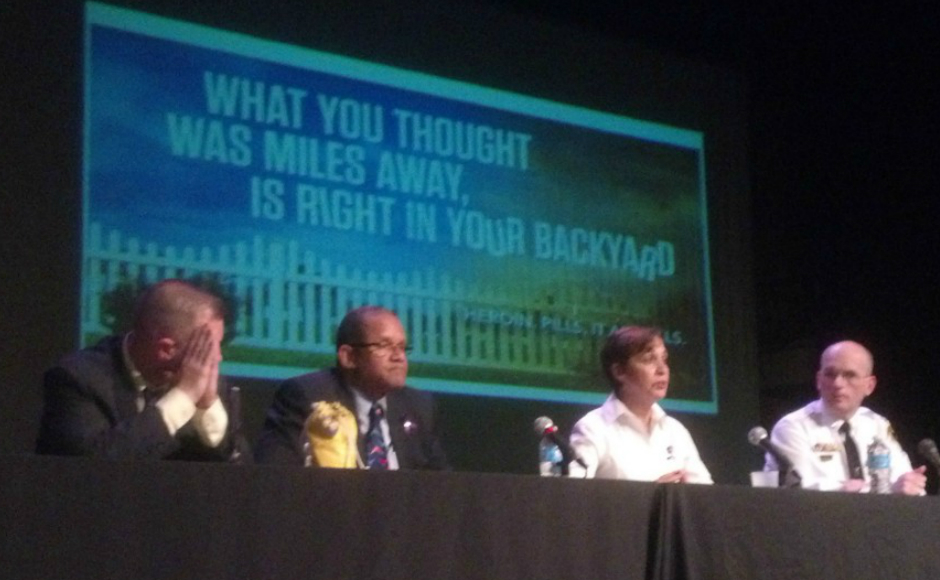Camden County officials hope a new, grassroots approach to heroin and opiate use will bring wholesale changes in the face of “epidemic” overdoses.
By Matt Skoufalos

Panelists at the summit advocate for comprehensive reform to the problem of drug abuse in Camden County.
Camden City has seen 171 deaths from drug overdose in 2014—and it’s only May.
Of those, 114 were out-of-towners, Camden County Freeholder Director Louis Cappelli said; data that he said proves the problems of the most dangerous city in America are not confined to its borders.
“Unfortunately, we have some of the best heroin in the nation.” Cappelli said.
The urgency and scope of opiate abuse seen throughout the region demands a more progressive handling of the situation, Cappelli said. A new, county-wide initiative to drive changes via municipal task forces kicked off with a summit at the Scottish Rite Auditorium in Collingswood on May 19.
Staffers handed out purple ribbons for “overdose awareness” at the door, and a crowd of several hundred stayed through the catered reception for a discussion with local medical, legal, and law enforcement experts.
The panel called for new approaches to the “opiate and heroin crisis,” such as broader access to replacement therapies and counseling, drug education programs that start younger and are based in medical evidence, and community policing that doesn’t abandon addicts to a criminal justice system ill-equipped to rehabilitate them.
“We have to get beyond the old thoughts about how we treat addiction,” Cappelli said.
‘Demonizing everything’
The social stigma related to drug abuse only worsens the problem, said Dr. Michael DeShields.
DeShields, who runs RecoveryCare Medical Associates, an addiction treatment center in Blackwood, said addiction is “a chronic, relapsing brain disease…no different from any [other]chronic disease.
“But we treat it differently,” he said, “demonizing the individual, the drug; demonizing everything.”
The finger-pointing is not only ignorant, DeShields said, but actually undermines efforts to address the problem. He cited a 2014 study in the Journal of Public Health Policy that found that public attitudes towards addiction “are largely inconsistent with medical knowledge,” and called for a need “to better align the language of addiction with the scientific evidence.”
“The brain is the target organ, and drugs change the brain,” he said. “It’s not the individual so much; it’s the drug working on the individual’s brain.”
With 2 million Americans reportedly dependent on prescription painkillers last year alone, DeShields said, the problem doesn’t begin with street drugs. At the outset, he said, “You know the dose, and you can’t possibly run into trouble.”
But as more opiates are required to achieve that first high, he said, users switch from swallowing pills to snorting them. The nasal lining is coated through repeated use, stifling the effect of the drug, and driving users to seek the more immediate vehicle of a needle.
“It’s because of physiology and economics that [drug users]travel down that slippery slope of IV use,” DeShields said, not because they started out seeking it.
‘We’re going to have more O.D.’s’
That attitude is shared by law enforcement leadership as well, as represented on the panel by Gloucester Township Police Chief W. Harry Earle.
“Nobody wakes up one day and says, ‘I want to start doing drugs,’” Earle said. “Something happened.”
In recognition of that, Earle said authorities must return to “the true basic meaning of community policing,” forming “partnerships, programs, and problem-solving techniques” to get at the root causes of the problem.
“We must understand that if we want to effectively stop this epidemic, we must do more than just arrest people,” he said. “The market is fluid, so [more drugs]will come from somewhere.”
“When people say, ‘There’s nothing I can do,’ that’s so inappropriate,” Earle said. “Just because treatment may be outside of what a local municipality can do, that doesn’t mean we can’t do anything.”
Despite the rampant abuse of prescription drugs, said Frank Greenagel, a clinical social worker who chaired the statewide opiate task force, addicts have been betrayed at the policy level by “toothless” regulations.
“If you wonder what a legalized drug market looks like, this is it,” he said.
Doctor and pharmacist participation in the New Jersey prescription drug monitoring program is voluntary, Greenagel said, and any hope of insurance reform “also is a unicorn,” making drug addiction “a political loser” for elected officials.
“People say we’ve turned the corner, but we haven’t,” he said. “We’re going to have more O.D.’s.”
Of the adolescents who participate in treatment programs, Greenagel said, “95 percent” use drugs within a month of returning to their high schools. Creating alternative magnet schools dedicated to addictions recovery could help, he said, but the idea is a tough sell.
“I have not come across a superintendent yet who wants to play ball,” he said. “There are 35 recovery high schools in the country; none [are]in New Jersey. They work.”
Incarceration costs taxpayers $55,000 per inmate per year, Greenagel said (“Rehab or college is cheaper”), which means the criminal justice problem is becoming an economic one. A recovery high school could help, he said, but communities “need prevention programs [that begin]at age 10.
“Thirteen is too late,” he said.




